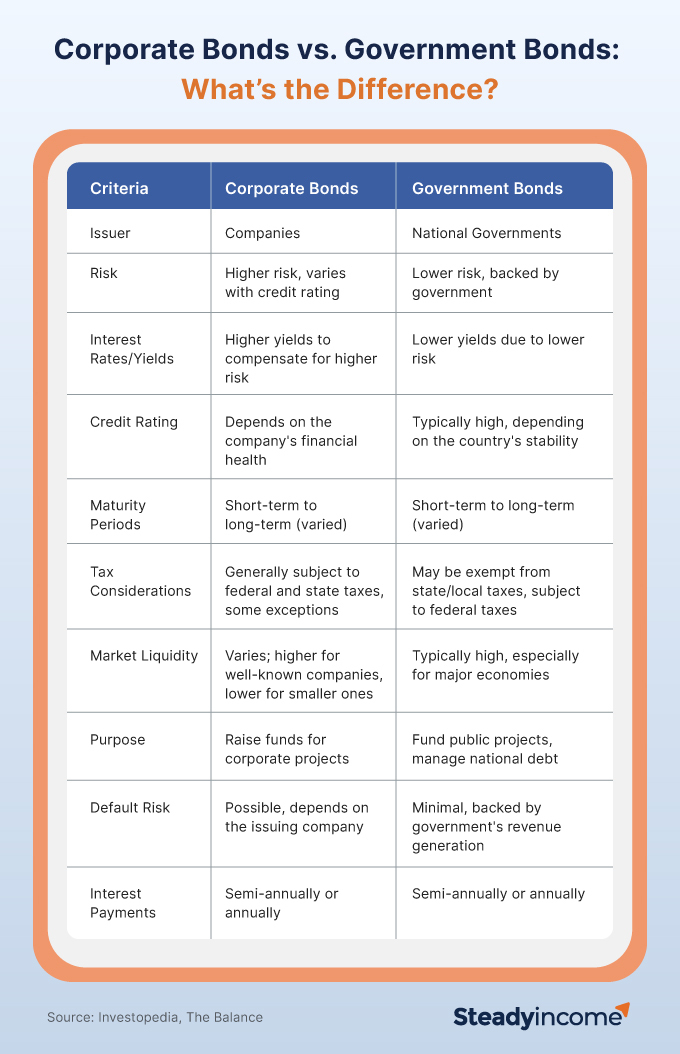Corporate Bonds vs. Government Bonds: What’s the Difference?

Investors seeking stable returns often turn to bonds, which are debt securities issued by entities to raise capital. Among the diverse types of bonds available, corporate bonds and government bonds stand out due to their popularity and distinct characteristics. Understanding the differences between these two can help investors make informed decisions based on their risk tolerance, investment goals, and market outlook.

1. Issuers and Purpose
Corporate Bonds: Corporate bonds are issued by companies to raise funds for various purposes, such as expanding operations, financing new projects, or refinancing existing debts. Companies from different sectors, ranging from technology to utilities, offer these bonds. The primary goal is to generate capital for growth and development, offering investors a fixed return in the form of interest payments.
Government Bonds: Government bonds, often referred to as sovereign bonds, are issued by national governments to fund public projects, infrastructure development, or to manage the national debt. These bonds are considered safer as they are backed by the government’s ability to tax its citizens and generate revenue. Examples include U.S. Treasury bonds, Indian Government Securities (G-Secs), and UK Gilts.
2. Risk and Credit Rating
Corporate Bonds: The risk associated with corporate bonds varies widely based on the issuing company’s creditworthiness. Companies with high credit ratings (AAA or AA) are considered low-risk, while those with lower ratings (BBB or below) are deemed higher risk. Investors are compensated for taking on additional risk through higher interest rates. However, corporate bonds carry the risk of default, where the issuing company might fail to make timely interest payments or return the principal amount.
Government Bonds: Government bonds are generally considered low-risk investments, particularly those issued by stable and economically strong countries. The risk of default is minimal, as governments have the authority to print money or adjust fiscal policies to meet their obligations. Consequently, government bonds often have lower yields compared to corporate bonds but offer a high degree of safety.
3. Interest Rates and Yields
Corporate Bonds: To attract investors, corporate bonds typically offer higher interest rates (or yields) compared to government bonds. The yield depends on the company's credit rating and prevailing market conditions. Higher yields on corporate bonds compensate investors for the increased risk. Interest payments, or coupons, are usually made semi-annually or annually.
Government Bonds: Government bonds usually offer lower yields due to their lower risk profile. The interest rates are influenced by the country’s monetary policy, inflation rates, and economic conditions. For instance, U.S. Treasury bonds are considered the benchmark for risk-free returns, often yielding less than corporate bonds. Interest payments are made regularly, similar to corporate bonds.
4. Maturity Periods
Corporate Bonds: The maturity period of corporate bonds can range from short-term (less than one year) to long-term (more than ten years). Companies issue bonds with varying maturities to match their financial strategies and project timelines. Investors have the flexibility to choose bonds that align with their investment horizon.
Government Bonds: Government bonds also come with varying maturities, from short-term (T-bills) to long-term (30-year bonds). The choice of maturity allows investors to plan their investment strategy according to their financial goals. Short-term bonds are ideal for liquidity, while long-term bonds offer stability and predictable returns.
5. Tax Considerations
Corporate Bonds: Interest income from corporate bonds is generally subject to federal and state income taxes. However, certain corporate bonds, such as municipal bonds issued by local governments, may offer tax advantages, including tax-exempt interest income.
Government Bonds: Interest income from government bonds may be exempt from state and local taxes but is typically subject to federal taxes. Some government bonds, like U.S. Savings Bonds, offer tax advantages for education expenses.
6. Market Liquidity
Corporate Bonds: Liquidity in the corporate bond market can vary. Bonds from well-established companies with high credit ratings are typically more liquid, meaning they can be easily bought or sold in the market. However, bonds from smaller or less-known companies may have lower liquidity, posing challenges for investors looking to exit their positions.
Government Bonds: Government bonds are usually highly liquid, especially those issued by major economies like the United States. They are actively traded in the secondary market, providing investors with the flexibility to buy or sell without significant price concessions. This liquidity is a key factor contributing to their popularity.
Conclusion
Both corporate bonds and government bonds play crucial roles in an investment portfolio. Government bonds offer safety and stability, making them suitable for conservative investors seeking predictable returns. In contrast, corporate bonds provide higher yields, appealing to investors willing to take on more risk for greater returns.
Investors should consider their risk tolerance, investment horizon, and financial goals when choosing between corporate and government bonds. A diversified portfolio that includes both types of bonds can help balance risk and return, providing a more resilient investment strategy. By understanding the differences and carefully evaluating each option, investors can make informed decisions to achieve their financial objectives.


